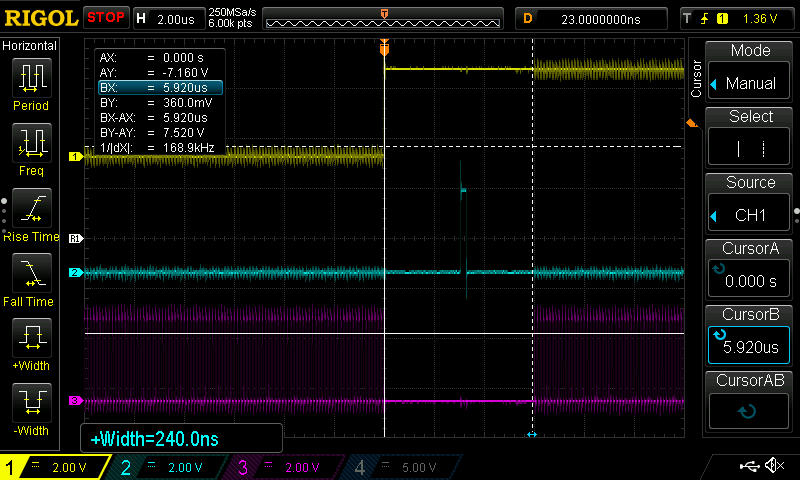ozcar wrote: Fri Mar 12, 2021 1:02 am
Edit: I've got a feeling I must have messed something up. Sounds too good (fast) to be true.
I had a chance to look at this again. I don't know exactly how, but I think the compiler was somehow thwarting my attempt to measure the timing. So, that was indeed too good to be true. Now I measured the time a different way - similar to what was done in another thread here. Still using the 72MHz F303.
With this in setup():
Code: Select all
attachInterrupt(PB10, receiver_ch1, CHANGE); //Connect changing PB10 to routine receiver_ch1
pinMode(PA0,OUTPUT); // set up two output lines for measuring time
digitalWrite(PA0, LOW);
pinMode(PA1,OUTPUT);
digitalWrite(PA1, LOW);
// use timer pwm to generate test signal - pwm output on PB11 tied to PB10 input to generate the interrupt.
// basically copied from pwm example.
TIM_TypeDef *Instance = (TIM_TypeDef *)pinmap_peripheral(PB_11, PinMap_PWM);
uint32_t channel = STM_PIN_CHANNEL(pinmap_function(PB_11, PinMap_PWM));
HardwareTimer *MyTim = new HardwareTimer(Instance);
MyTim->setPWM(channel, pinNametoDigitalPin(PB_11), 5, 10); // 5 Hertz, 10% dutycycle
I put this in loop( ):
Code: Select all
while (1)
{
GPIOA->BSRR = GPIO_BSRR_BS_1;
GPIOA->BSRR = GPIO_BSRR_BR_1;
}
That generates pulses around 97ns apart on PA1. By observing those, I can see how long the mainline code goes out-to-lunch when the interrupt occurs (absence of pulses during that time). With a completely empty interrupt routine, the pulses disappear for around 5.7μs.
I then added code to the interrupt routine to flip another GPIO:
Code: Select all
void receiver_ch1()
{
GPIOA->BSRR = GPIO_BSRR_BS_0; // Indicate start of interrupt processing
// interrupt processing to occur here
GPIOA->BSRR = GPIO_BSRR_BR_0; // Indicate end of interrupt processing
}
That produced a less than 20ns pulse in the middle of the out-to-lunch time (which was near enough still 5.7μs).
Then, with Leonardo's logic in the interrupt routine, but using normal digitalRead():
Code: Select all
void receiver_ch1()
{
GPIOA->BSRR = GPIO_BSRR_BS_0; // Indicate start of interrupt processing
uint32_t now = DWT->CYCCNT; //Store the current micros() value
if ( digitalRead(PB10) ) receiver_input1_previous = now; //If input PB10 is high start measuring the time
else receiver_input1 = now - receiver_input1_previous; //If input PB10 is low calculate the total pulse time
GPIOA->BSRR = GPIO_BSRR_BR_0; // Indicate end of interrupt processing
}
Result: PA0 pulse 2.08μs ( time spent in receiver_ch1() ), out-to-lunch 7.4μs (total interrupt time).
Then using:
Code: Select all
if ( digitalReadFast(digitalPinToPinName(PB10)) ) receiver_input1_previous = now;
Result: PA0 pulse 1.92μs, out-to-lunch 7.3μs.
Then using:
Code: Select all
if ( digitalReadFast(PB_10) ) receiver_input1_previous = now;
Result : PA0 pulse 1.68μs, out-to-lunch 7.1μs.
Then going full circle, and effectively doing what Leonardo was doing in the first place:
Code: Select all
if ( GPIOB->IDR & GPIO_IDR_10 ) receiver_input1_previous = now;
Result: PA0 pulse 1.36μs, out-to-lunch 6.7μs
Finally, using DWT->CYCCNT instead of micros():
Code: Select all
void receiver_ch1()
{
GPIOA->BSRR = GPIO_BSRR_BS_0; // Indicate start of interrupt processing
uint32_t now = DWT->CYCCNT; // use cycle count instead of micros()
if ( GPIOB->IDR & GPIO_IDR_10 ) receiver_input1_previous = now; //If input PB10 is high start measuring the time
else receiver_input1 = now - receiver_input1_previous; //If input PB10 is low calculate the total pulse time
GPIOA->BSRR = GPIO_BSRR_BR_0; // Indicate end of interrupt processing
}
Of course, the cycle count would have to be translated to something useful, but that does not have to be done in the interrupt routine.
Result: PA0 pulse 240ns, out-to-lunch 5.9μs.
This is what that looks like (top trace is PB10/PB11 causing the interrupt, middle trace is PA0 showing the time in receiver_ch1(), and the bottom trace is PA1 showing the "out-to-lunch" gap in activity):

- f303time.jpg (95.21 KiB) Viewed 4157 times
Given that now only around 4% of the interrupt time is in receiver_ch1(), would probably have to attack or avoid the STM32DUINO and/or HAL code to make any improvement.